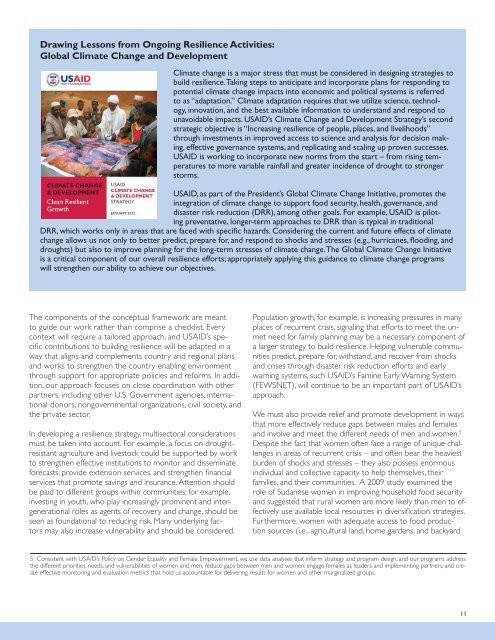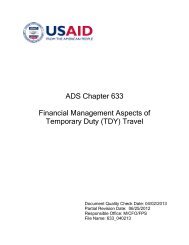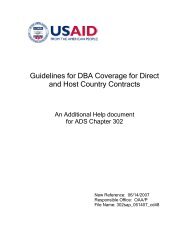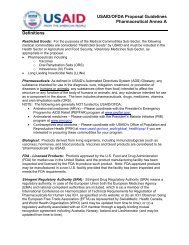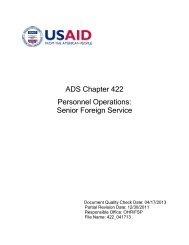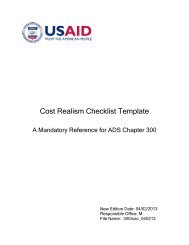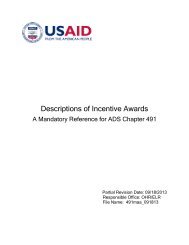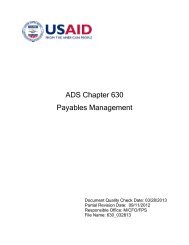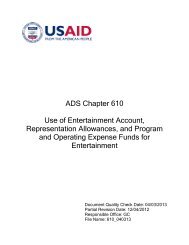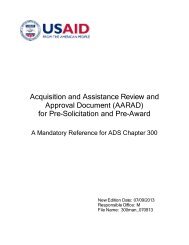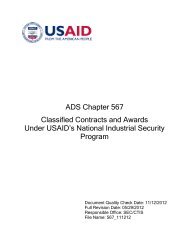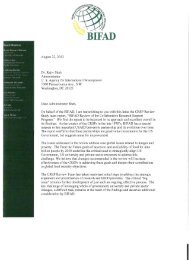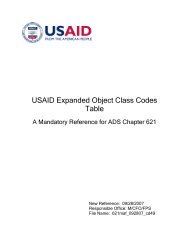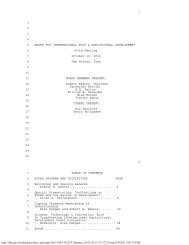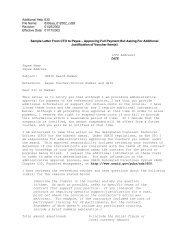USAID Policy Document - Resiliency FINAL 11-26-12.indd
USAID Policy Document - Resiliency FINAL 11-26-12.indd
USAID Policy Document - Resiliency FINAL 11-26-12.indd
- No tags were found...
Create successful ePaper yourself
Turn your PDF publications into a flip-book with our unique Google optimized e-Paper software.
Drawing Lessons from Ongoing Resilience Activities:Global Climate Change and DevelopmentClimate change is a major stress that must be considered in designing strategies tobuild resilience. Taking steps to anticipate and incorporate plans for responding topotential climate change impacts into economic and political systems is referredto as “adaptation.” Climate adaptation requires that we utilize science, technology,innovation, and the best available information to understand and respond tounavoidable impacts. <strong>USAID</strong>’s Climate Change and Development Strategy’s secondstrategic objective is “Increasing resilience of people, places, and livelihoods”through investments in improved access to science and analysis for decision making,effective governance systems, and replicating and scaling up proven successes.<strong>USAID</strong> is working to incorporate new norms from the start – from rising temperaturesto more variable rainfall and greater incidence of drought to strongerstorms.<strong>USAID</strong>, as part of the President’s Global Climate Change Initiative, promotes theintegration of climate change to support food security, health, governance, anddisaster risk reduction (DRR), among other goals. For example, <strong>USAID</strong> is pilotingpreventative, longer-term approaches to DRR than is typical in traditionalDRR, which works only in areas that are faced with specific hazards. Considering the current and future effects of climatechange allows us not only to better predict, prepare for, and respond to shocks and stresses (e.g., hurricanes, flooding, anddroughts) but also to improve planning for the long-term stresses of climate change. The Global Climate Change Initiativeis a critical component of our overall resilience efforts; appropriately applying this guidance to climate change programswill strengthen our ability to achieve our objectives.The components of the conceptual framework are meantto guide our work rather than comprise a checklist. Everycontext will require a tailored approach, and <strong>USAID</strong>’s specific contributions to building resilience will be adapted in away that aligns and complements country and regional plansand works to strengthen the country enabling environmentthrough support for appropriate policies and reforms. In addition,our approach focuses on close coordination with otherpartners, including other U.S. Government agencies, internationaldonors, nongovernmental organizations, civil society, andthe private sector.In developing a resilience strategy, multisectoral considerationsmust be taken into account. For example, a focus on droughtresistantagriculture and livestock could be supported by workto strengthen effective institutions to monitor and disseminateforecasts, provide extension services, and strengthen fi nancialservices that promote savings and insurance. Attention shouldbe paid to different groups within communities; for example,investing in youth, who play increasingly prominent and intergenerationalroles as agents of recovery and change, should beseen as foundational to reducing risk. Many underlying factorsmay also increase vulnerability and should be considered.Population growth, for example, is increasing pressures in manyplaces of recurrent crisis, signaling that efforts to meet the unmetneed for family planning may be a necessary component ofa larger strategy to build resilience. Helping vulnerable communitiespredict, prepare for, withstand, and recover from shocksand crises through disaster risk reduction efforts and earlywarning systems, such <strong>USAID</strong>’s Famine Early Warning System(FEWSNET), will continue to be an important part of <strong>USAID</strong>’sapproach.We must also provide relief and promote development in waysthat more effectively reduce gaps between males and femalesand involve and meet the different needs of men and women. 5Despite the fact that women often face a range of unique challengesin areas of recurrent crisis – and often bear the heaviestburden of shocks and stresses – they also possess enormousindividual and collective capacity to help themselves, theirfamilies, and their communities. A 2009 study examined therole of Sudanese women in improving household food securityand suggested that rural women are more likely than men to effectivelyuse available local resources in diversifi cation strategies.Furthermore, women with adequate access to food productionsources (i.e., agricultural land, home gardens, and backyard5 Consistent with <strong>USAID</strong>’s <strong>Policy</strong> on Gender Equality and Female Empowerment, we use data analyses that inform strategy and program design, and our programs addressthe different priorities, needs, and vulnerabilities of women and men; reduce gaps between men and women; engage females as leaders and implementing partners; and createeffective monitoring and evaluation metrics that hold us accountable for delivering results for women and other marginalized groups.<strong>11</strong>


